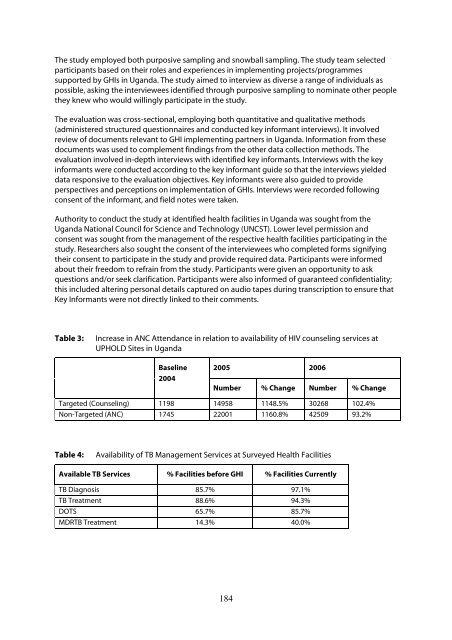MAXIMIZING POSITIVE SYNERGIES - World Health Organization
MAXIMIZING POSITIVE SYNERGIES - World Health Organization
MAXIMIZING POSITIVE SYNERGIES - World Health Organization
Create successful ePaper yourself
Turn your PDF publications into a flip-book with our unique Google optimized e-Paper software.
The study employed both purposive sampling and snowball sampling. The study team selected<br />
participants based on their roles and experiences in implementing projects/programmes<br />
supported by GHIs in Uganda. The study aimed to interview as diverse a range of individuals as<br />
possible, asking the interviewees identified through purposive sampling to nominate other people<br />
they knew who would willingly participate in the study.<br />
The evaluation was cross-sectional, employing both quantitative and qualitative methods<br />
(administered structured questionnaires and conducted key informant interviews). It involved<br />
review of documents relevant to GHI implementing partners in Uganda. Information from these<br />
documents was used to complement findings from the other data collection methods. The<br />
evaluation involved in-depth interviews with identified key informants. Interviews with the key<br />
informants were conducted according to the key informant guide so that the interviews yielded<br />
data responsive to the evaluation objectives. Key informants were also guided to provide<br />
perspectives and perceptions on implementation of GHIs. Interviews were recorded following<br />
consent of the informant, and field notes were taken.<br />
Authority to conduct the study at identified health facilities in Uganda was sought from the<br />
Uganda National Council for Science and Technology (UNCST). Lower level permission and<br />
consent was sought from the management of the respective health facilities participating in the<br />
study. Researchers also sought the consent of the interviewees who completed forms signifying<br />
their consent to participate in the study and provide required data. Participants were informed<br />
about their freedom to refrain from the study. Participants were given an opportunity to ask<br />
questions and/or seek clarification. Participants were also informed of guaranteed confidentiality;<br />
this included altering personal details captured on audio tapes during transcription to ensure that<br />
Key Informants were not directly linked to their comments.<br />
Table 3: Increase in ANC Attendance in relation to availability of HIV counseling services at<br />
UPHOLD Sites in Uganda<br />
Baseline<br />
2004<br />
2005 2006<br />
Number % Change Number % Change<br />
Targeted (Counseling) 1198 14958 1148.5% 30268 102.4%<br />
Non-Targeted (ANC) 1745 22001 1160.8% 42509 93.2%<br />
Table 4: Availability of TB Management Services at Surveyed <strong>Health</strong> Facilities<br />
Available TB Services % Facilities before GHI % Facilities Currently<br />
TB Diagnosis 85.7% 97.1%<br />
TB Treatment 88.6% 94.3%<br />
DOTS 65.7% 85.7%<br />
MDRTB Treatment 14.3% 40.0%<br />
184

















